Gmail and Microsoft 365 Migration Options
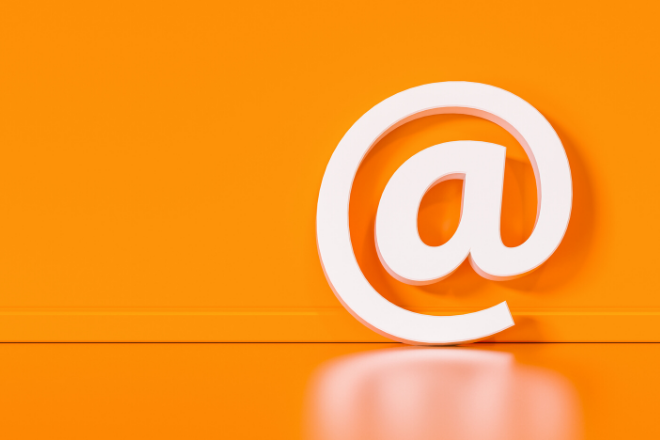
We’ve been running Exchange migrations to/from Microsoft 365 and Gmail since 2015 and as of this month all our users are on our latest tech (Microsoft 365 / Office 365). With all the new modern tools and Microsoft cloud tech you’ll automatically get backend updates from here on out and hopefully the words “email migration” will never come up for you.
We realize that there are some clients that would prefer to move their mail elsewhere so before we retire all our legacy infrastructure, we are making one final offer. We can manage your migration, either by just providing the pst export of data or managing the entire process end to end.
The cost for the PST export is $39/mailbox if you’d like us to handle it for you (or you can do it for free yourself), and the cost for the full migration service is $59/mailbox.
PST Export ($39/mailbox) includes exporting your data to a standard PST file and making it available on a secure web site.
Full migration ($59/mailbox) includes the export as well as the following:
– Mail proxied through ExchangeDefender delivering to current mailbox as well as the mailbox at the new location, allowing you to stay in business even while we do the mail moves.
– DNS management including configuration of the new SPF, DKIM/DMARC, and MX records.
– Current mail (pst) upload to the new mailbox
– Disconnection/removal of the existing email infrastructure
– Warranty and support for the whole process.
We recommend going with the full migration including a year of ExchangeDefender service. This option allows us to make sure the configuration is accurate on both clouds, that data is moved correctly and securely, that MX/SPF/DKIM/DMARC are operational and do not cause issues down the road, as well as LiveArchive to assure that should anything go wrong you can still send/receive email.
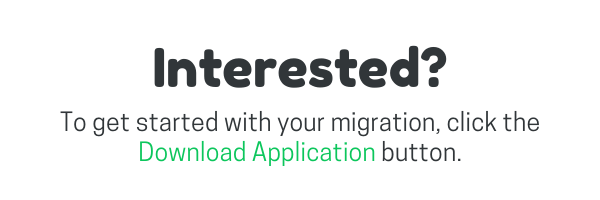
P.S. If you have basic IT skills, or if you work with an IT/MSP/VAR/tech provider, you can do this on your own. Simply make the following changes to your hosts file and you will be able to connect Microsoft Outlook and export mail to a pst file on your own. Our legacy systems will be permanently retired on August 1st, 2020.
#72.249.181.167 autodiscover.YOURDOMAIN_ON_SCROOGE.com
#72.249.181.162 cas.scrooge.exchangedefender.com
#65.99.255.121 autodiscover.YOURDOMAIN_ON_ROCKERDUCK.com
#65.99.255.37 cas.rockerduck.exchangedefender.com
#72.249.181.149 autodiscover.YOURDOMAIN_ON_GLADSTONE.com
#72.249.181.232 cas.gladstone.exchangedefender.com
#65.99.255.26 autodiscover.YOURDOMAIN_ON_LOUIE.com
#65.99.255.58 cas.louie.exchangedefender.com
#72.249.181.123 autodiscover.YOURDOMAIN_ON_DARKWING.com
#72.249.181.238 cas.darkwing.exchangedefender.com
If you are interested in this offering, please download the application and submit it to us via ticket at https://support.ownwebnow.com
or call us at 877-546-0316 x720
Final Update: Exchange Migration

We wanted to offer one final update before we close the ExchangeDefender NOC covering our Exchange migration.
The past few days have been largely consumed with cleanup and misc configuration requests already covered here. By far the biggest issue has been reseeding and legacy copies of mailboxes exceeding 25GB – using nearly all internal, Microsoft/powershell, and third party tools there seems to be no predictable, foolproof, failsafe way to migrate a mailbox. The larger mailbox gets, the more difficult it seems to port (one particular user has been waiting on their mail for 2 weeks – they have a 70 GB mailbox – and it’s taken dozens of attempts of repair/recheck/export/move/seed/verify) and it has been the greatest source of frustration for us and for our clients, largely because the progress indicators are unreliable and process very prone to failure the larger the mailbox gets. This is why when we started offering 2016 years ago we set up the 50GB quota with 15GB realtime and 35GB in place archive setup so we can deliver on both service restoration and disaster recovery.
We are continuing to assist our partners in the following areas:
– Outlook connectivity (if it keeps on prompting you for a password you need autodiscoverregistryhacks.zip)
– Distribution Group (External) and External Forwards UI (we discovered a bug, the control panel will be back over the weekend and in meantime we’ll create it for you manually with a ticket request)
– Cancelled services (as of yesterday 6/18 we have the ability to remove organizations from ExchangeDefender/O365, so if you client cancelled or went to another service even within O365, open a ticket and request that we delete the org. You can do so on your own as well if you’ve deleted all the mailboxes/forwards/groups.)
– IoT/SMTP (while Exchange/O365 does support SMTP connectivity, managing it through our IoT connector is far more secure and reliable)
– Implementation of Shared Mailboxes. Please, please, please, please DO NOT use Public Folders anymore, for any purpose. Create a Shared Mailbox instead.
At this point everyone can connect, mail delivery and legacy reseeding are in progress, all systems for Exchange, ExchangeDefender, and LiveArchive are working normally.
We’re looking forward to closing this ugly chapter. We have done everything in our power, and we couldn’t be more thankful for our partners who have helped us with the cleanup of the Microsoft disaster. Thank you. We are sorry that so many clients were inconvenienced with this, we planned and managed every step of this migration by the book with thousands of other successful migrations that happened from 2016 – Aug 2019, but when your vendor pulls the rug underneath you and damages hundreds of mailboxes unannounced… many of us will soon be enjoying the first day off in June. The only good news is, you will not have to go through this process again.
Exchange After-Migration Update
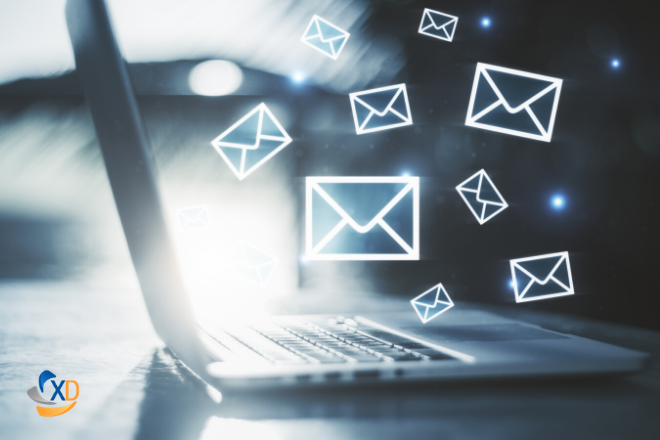
We wanted to offer a major update on the migration, specifically covering the major issues we have addressed for some clients during the cleanup phase.
Distribution groups, forwarding
We have received reports from several organizations regarding issues covering distribution groups, group members, forwarding account directions (forward vs. store & forward). If any objects failed to import due to configuration/contents/policy/etc it is in the retry queue and will be published shortly.
Add / Delete Mailbox
We have addressed a bug in the add/remove process that was prohibiting certain organizations to add/remove accounts. Originally, as noted on anythingdown.com NOC, we blocked this function entirely because users were looking at an empty list and creating mailboxes (that would cause a collision when the new mailbox was migrated from the source). This problem is fixed, if you encounter an issue please open a ticket with a screenshot and as much info as you can provide.
Add / Delete Organization/Domain
At this moment it is not possible to add/remove organizations, or those that were in the system recently. In order to finalize the migration, the routing policies are locked down (meaning if you deleted a domain, ExchangeDefender will still treat them as local). We look forward to wrapping this up shortly.
Password / Login issues
This is by far the biggest ticket group category, we are still processing double digit requests for credentials, credential resets, and credential tests. Similar to the next group:
Outlook issues
We are still spending a lot of time going through the basic Outlook configuration steps. For an overwhelming majority, this transition has been transparent. Those that did not and had to take a manual configuration route, the process has been described at anythingdown.com 1) Make sure you have an autodiscover record 2) Make sure it propagates, then run the autodiscoverregistryhacks.zip 3) If you don’t control your DNS, make adjustments to your local systems hosts file 4) Setup Outlook with autodiscover, the UPN must be used as your login address if you’ve changed it from your primary SMTP address.
Missing & Syncing Emails
Every mailbox that has been reconnected has either had all it’s mail delivered directly, delivered in a Catchall account – user@domain.com. Some users are confusing items they see in their Inbox in LiveArchive but not in their Outlook/OWA (but after extensive searching we keep on finding missing messages in folders, Deleted Items, etc). If something is missing and absolutely critical in LiveArchive just click on the message and click Forward to your email address and the message will be forwarded to your Outlook/OWA.
Store & Forward
Several users were also unfortunately caught up in a custom policy that did not get migrated to the new Exchange. These are more legacy configs we did for some users in AUDC, things like renaming the OU or primary domains. For some of those accounts, the store and forward rule because a forwarding only rule, skipping the Inbox and going straight to the person that it’s being copied to. We have fixed this issue and it should not be happening again.
Autodiscover
We have gotten several complaints about autodiscover. Microsoft has removed manual configurations in 2013 and no modern version of Microsoft Exchange supports a manual server setup. However, this is something that could be easily rectified even with minimal technical skills by modifying the local hosts file if you don’t have the credentials to do it properly by modifying the DNS. Absolutely everything in the new infrastructure relies on the autodiscover record!
iPhone / Android Setup
For the most part, we are just confirming that all mobile devices should work fine with owa.xd.email as the server name, ditto for EWS integrated applications, we have not received more than an inquiry for the server name. For Android, things get sketchier when you consider all the different vendors, apps, and configurations. Again, so long as autodiscover is present and configured properly and your device is using a modern client, it should just work. When it doesn’t, recreating it takes a few minutes.
NDR
Non delivery receipts and errors are always of high interest to our NOC team as we continue to go through cleanup and audit all the tickets and users.
These are the issues we are currently working on, in 3 shifts, and sorting them all out as fast as possible. I know that for many of our clients this transition has been messy, but you are on such a better and more secure platform that won’t require you go through this process again. While modern platforms are more secure, their recovery from a disaster or issue (as some of you unfortunately went through) is extensive and at times unpredictably slow – so you have this much of a commitment for us, we will make sure LiveArchive is able to step in on a whole new level when things like this happen.
Important links to remember
ExchangeDefender NOC
www.anythingdown.com or https://xdinternal.xdnoc.com/
ExchangeDefender Exchange Setup
https://www.exchangedefender.com/blog/2020/06/exchangedefender-exchange-setup/
Autodiscover Registry Hacks
https://www.exchangedefender.com/media/autodiscoverregistryhacks.zip
ExchangeDefender Service Documentation (Knowledgebase)
www.exchangedefender.com/documentation
ExchangeDefender Exchange Setup

This guide is intended for IT solution providers, CIO, and technical staff that is in charge of setting up and managing email. While Exchange is a very complex and robust environment, our control panel is designed to help personnel of all technical skill levels manage email. In Figure 1 above you can see our Service Manager, the user friendly way to manage every aspect of email in your Exchange organization.
This site is accessible at https://support.ownwebnow.com and your MSP/CIO has access to manage the Service Manager on demand. For the purposes of this guide, we only reference this site because it is where management begins: the rest of the guide is to help every user configure their Microsoft Outlook, or mobile Android / iOS devices.
Important Server Names
Microsoft Outlook, iOS and Android devices connect to the Microsoft Exchange infrastructure through several web services. If your IT provider has configured your Autodiscover DNS properly, you will never need to know about these sites, but it is important to know where the resources are in the event that you need to configure something more complex to work with Exchange. Figure 2.

Each Exchange organization managed by ExchangeDefender has their own branded set of OWA, EWS, and Autodiscover records. While we recommend you use the branded one for your organization, the default ones will work the same way and they all point to the same network resources.
Outlook Web App
https://owa.xd.email/owa/
Outlook Web App (formerly known as Outlook Web Access) is the web version of Outlook that works in your browser. While not as powerful or as flexible as Outlook, unless you are a power user, it will do the job. You can point your cell phone, tablet, laptop, or workstation to the URL above and it will give you access to the most popular Outlook features over the web.
EWS URL
https://owa.ownwebnow.xd.email/EWS/Exchange.asmx
Exchange Web Services (EWS) is the web service endpoint for advanced configurations. If you need to integrate a service or a device with Exchange Web Services, this is the URL to use. As of Exchange 2013, there is no support MAPI.
Autodiscover
autodiscover.xd.email
Exchange Autodiscover service makes it easy to deploy Outlook without providing manual configuration parameters – all you need is your email address and your password. Since 2013, Autodiscover has become the only way to configure Outlook/Exchange and manual configuration is no longer possible. If you do not have Autodiscover record in your DNS you need to create it and point it as a CNAME to autodiscover.xd.email (if this is not possible for some reason, see Appendix A)
ExchangeDefender Admin Control Panel
https://admin.exchangedefender.com
Managing ExchangeDefender security, including the included Exchange antispam, antiphishing, and business continuity services, is done through our admin control panel. Most organizations are managed through the domain login (domain.com) or user login (user@domain.com). Please see https://www.exchangedefender.com/docs for more information on how to manage this powerful service.
ExchangeDefender Next Generation LiveArchive (NGE)
https://nge.exchangedefender.com
ExchangeDefender LiveArchive is a business continuity (email resilience) platform independent of Microsoft Exchange that is running in parallel with your email infrastructure. When Microsoft Exchange experiences a technical problem, you can still send and receive email from any device using the same email and password that you use for Outlook and OWA. Please see https://www.exchangedefender.com/docs for more information.
Configuring Outlook
For the purposes of this guide, we are assuming that your IT personnel has already created all the required DNS records (MX, SPF, DKIM, and most importantly, Autodiscover) and that you know your login credentials (you can test them by going to https://owa.xd.email/owa/)
Step 1: Download and run Outlook Registry Tools
Open your web browser and go to the following site: https://www.exchangedefender.com/media/autodiscoverregistryhacks.zip
Step 2: Open the Outlook Registry Tools
Click on autodiscoverregistryhacks.zip to open the archive (Figure 3):

Figure 3: Batch files for Outlook registry entries
Find the version of Outlook you have (registryhacks2016 will work for both Outlook 2016 and 2019) and drag it to the desktop.
Click on Start, type cmd, and then right click on the Command Prompt.
Click on Run as administrator.
Change directory to your desktop: cd C:\Users\YourUsername\Desktop\
Note: Please substitute your username for YourUsername in the path. My example is C:\Users\Vlad\Desktop\
Run the batch file you extracted and moved to your desktop in the previous step. If you do it right, this is the output you will see (Figure 4):

Figure 4: Registry entries being added
IMPORTANT: Reboot your PC.
Step 4: Outlook Configuration
Start Microsoft Outlook and your configuration wizard will start. This process can take a few minutes for each step to be complete, if you’re waiting more than 10 minutes something is likely not done correctly.

Figure 5: Outlook Welcome

Select Exchange.
Your system will now contact the Autodiscover web service to obtain all the Microsoft Outlook configuration credentials. If it worked, you will be prompted to accept server settings:

Next you will have to provide your password.

Microsoft Outlook will now authenticate with our servers and configure everything for you. Next you should see the notification that Account successfully added.

Click on the link on the bottom under Done and confirm that checkbox is not checked next to Set up Outlook Mobile on my phone, too. Figure:
That is all! You are set and ready to go. Microsoft Outlook will now continue to set everything up and in a few moments.

That is all, enjoy Microsoft Outlook powered by ExchangeDefender managed Exchange.
Managing Calendar Permissions
Designed for Outlook 2013/2016
Select the Calendar button in the Navigation Bar.
Select the calendar that you would like to share, right-click on the Calendar and choose Share > Calendar Permissions.
On the Permissions tab, you may add or remove users to whom you have delegated access to your calendar.
To add a new delegate, select Add… and search for the desired user by Last Name. You can search the Global Address List or your personal contacts list by selecting the appropriate dropdown menu under Address Book. Under the Permissions heading, choose the level of detail you would like to provide to the user.
To remove a delegate, select the user and choose Remove.
Choose Apply > OK.
Configuring iOS Devices (iPhone, iPad)
Configuring iOS Devices is very simple. Just start your Mail app and you will be prompted to setup a new account. Select Microsoft Exchange, second option from the top.

Next, you will be prompted for your account credentials. Your login credentials are the same as for Outlook Web Access.

Tap on Next.
Your device will now attempt to locate the Autodiscover server and obtain all the settings.
You will be prompted to verify server identity, tap on Continue.

Next, you will be prompted to provide the server and login credentials, same as in the previous screen.
Server for iOS is owa.xd.email

Tap on Next.
After a few minutes the device will autoconfigure and allow you to select which iOS applications should sync data with the Exchange server.

Make your selection and tap Save.
Android Setup
Android setup is very similar to iOS but most vendors use their own email app. If you choose to use the stock Android Gmail app, or other Android phone vendor email app, you will need to know your:
Server address: owa.xd.email
Username & password which are the same as the ones you use to login to https://owa.xd.email/owa/
Configuring MacOS X with ExchangeDefender Exchange
The following instructions are for MacOS Catalina, and the instructions work very similarly for all other versions of MacOS X. So long as you have your Autodiscover record configured properly, your setup process will just require your email address, password, and a few clicks along the way.
1.First, start the MacOS Mail app. If you aren’t prompted to add an account click on Mail > Add Account
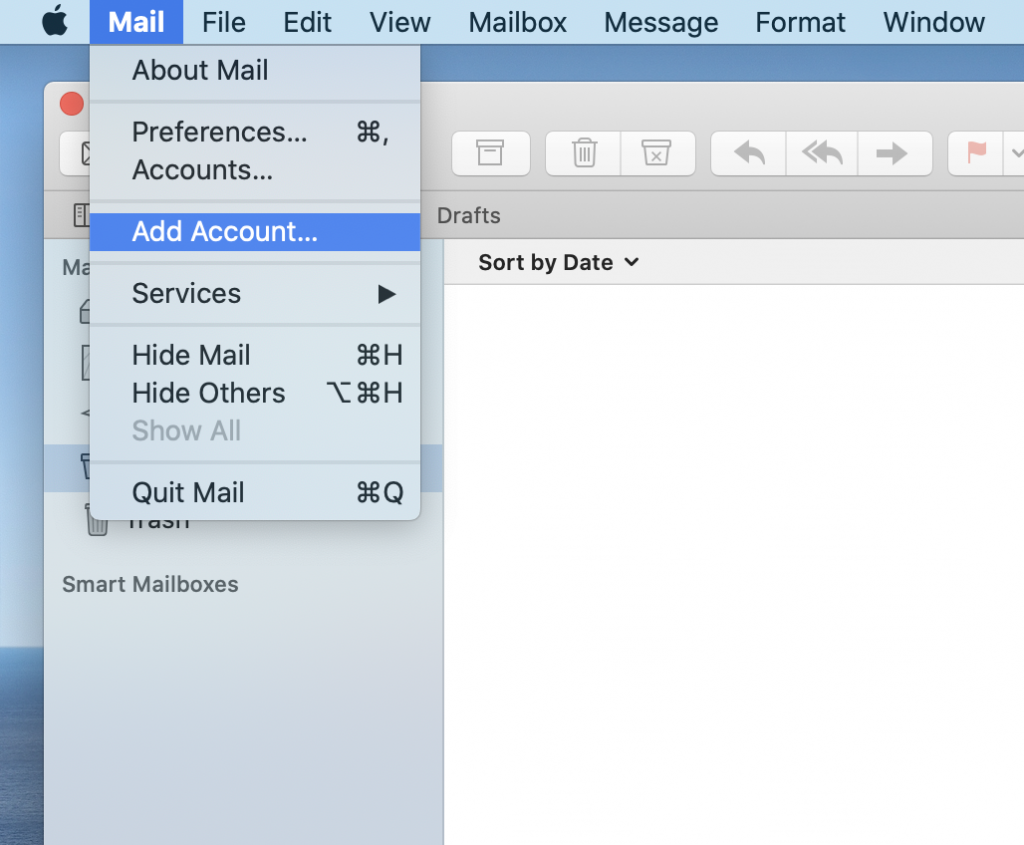
2. Select Exchange from the “Choose a Mail account provider…” screen. Click Continue.
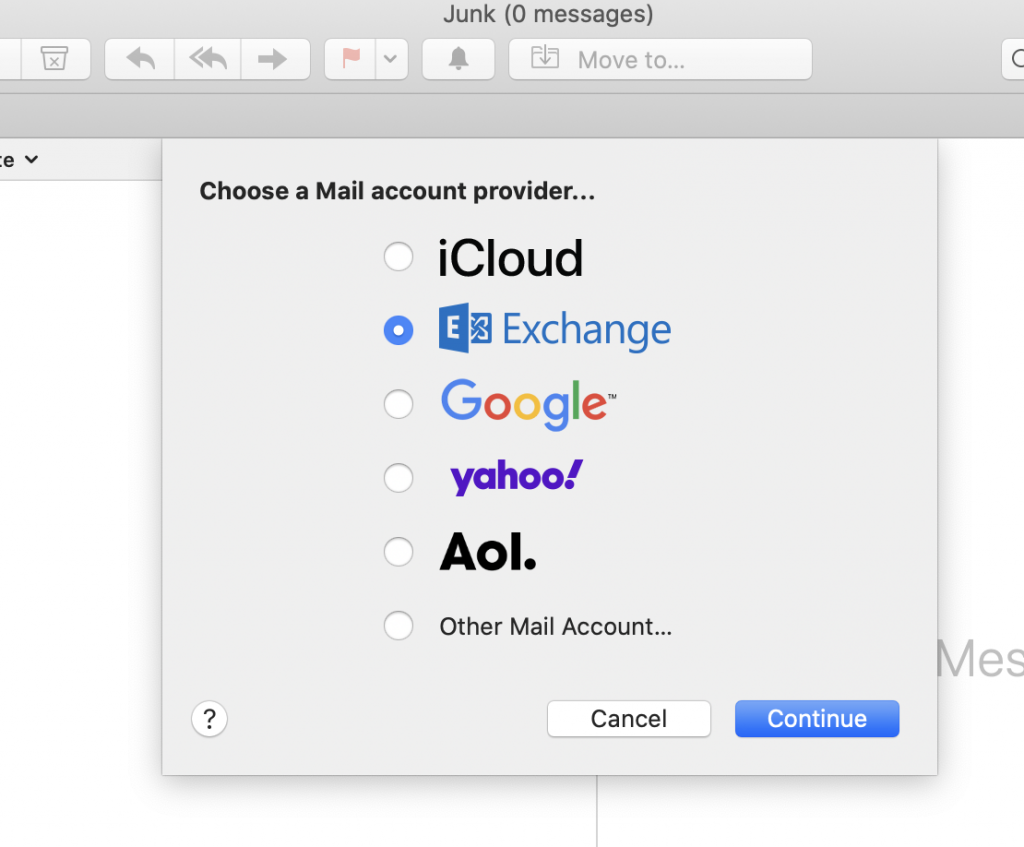
3. You will now be prompted for your name and email address. Type them in and click Continue.
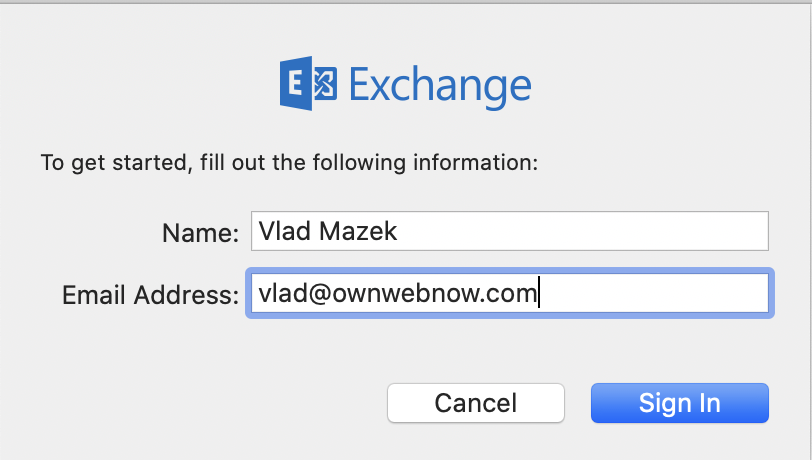
4. This is where Autodiscover kicks in. Manual setup is not supported. Click on Sign In.
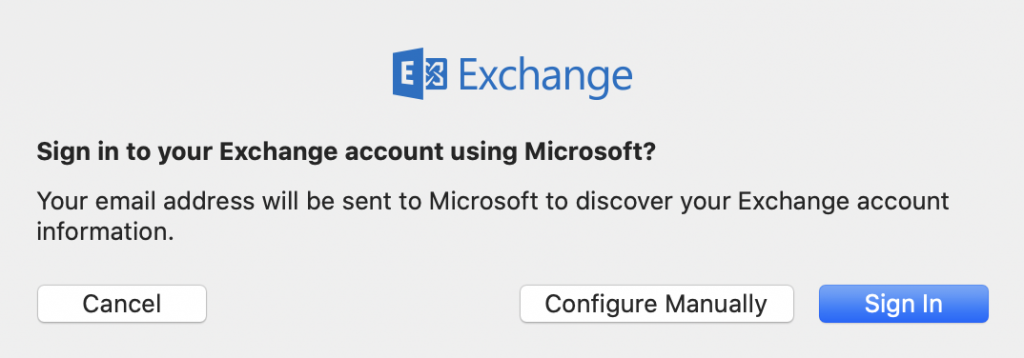
5. Type in your ExchangeDefender password and click on Sign In.
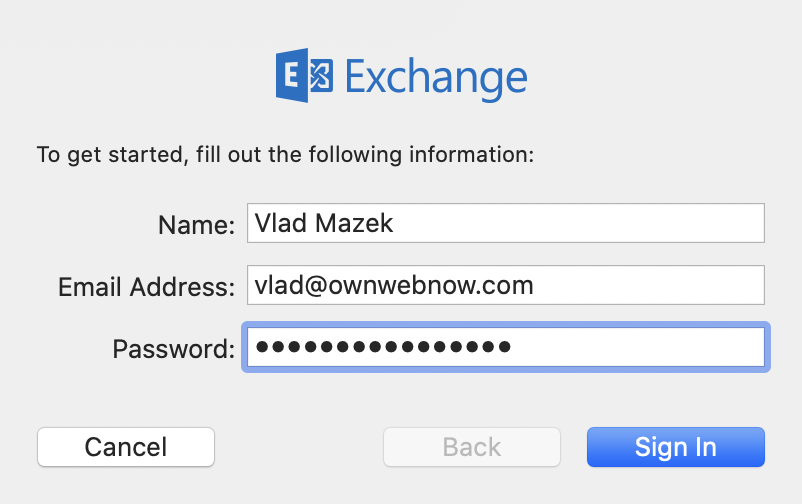
6. You will be prompted to accept an SSL certificate. Click on Continue.
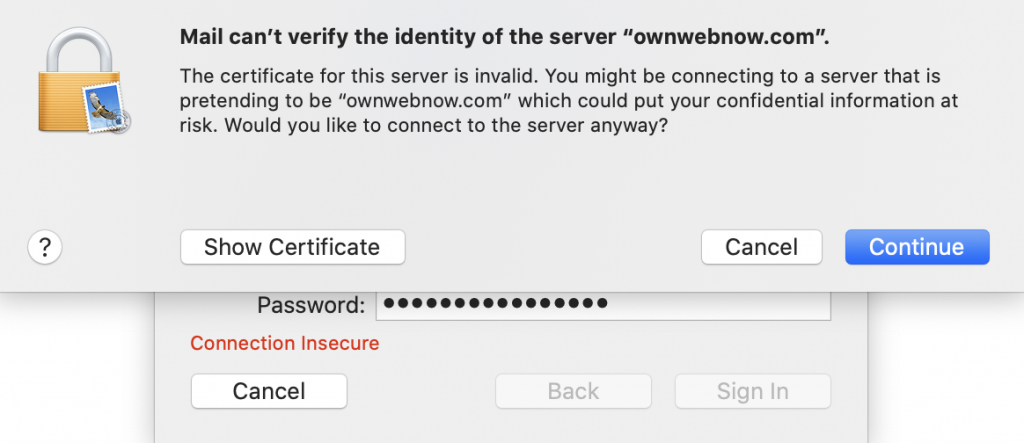
7. You will now be prompted to add the certificate. Please type in your MacOS X password here. Click on Update Settings.
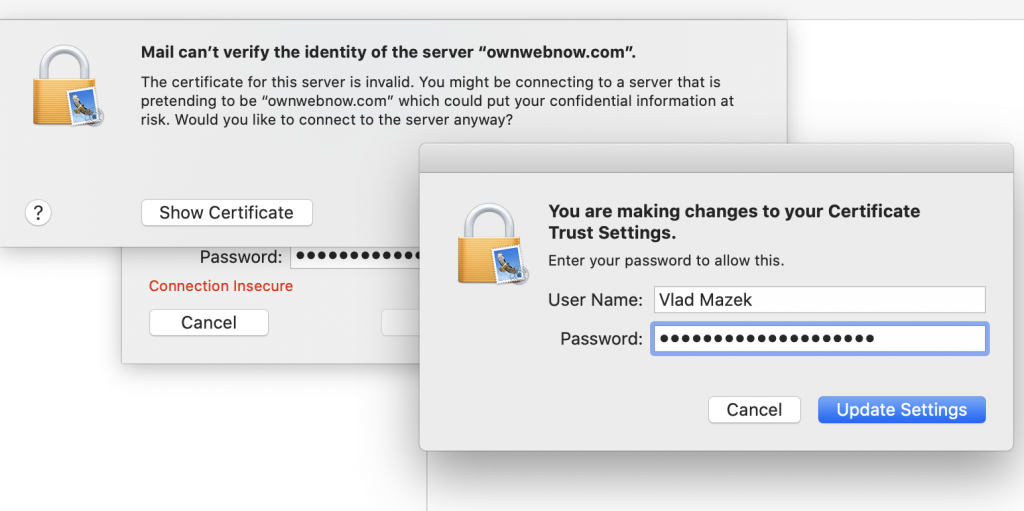
8. You will now be prompted which apps you want to have access and sync with your Exchange data. Make an appropriate selections and click Done.
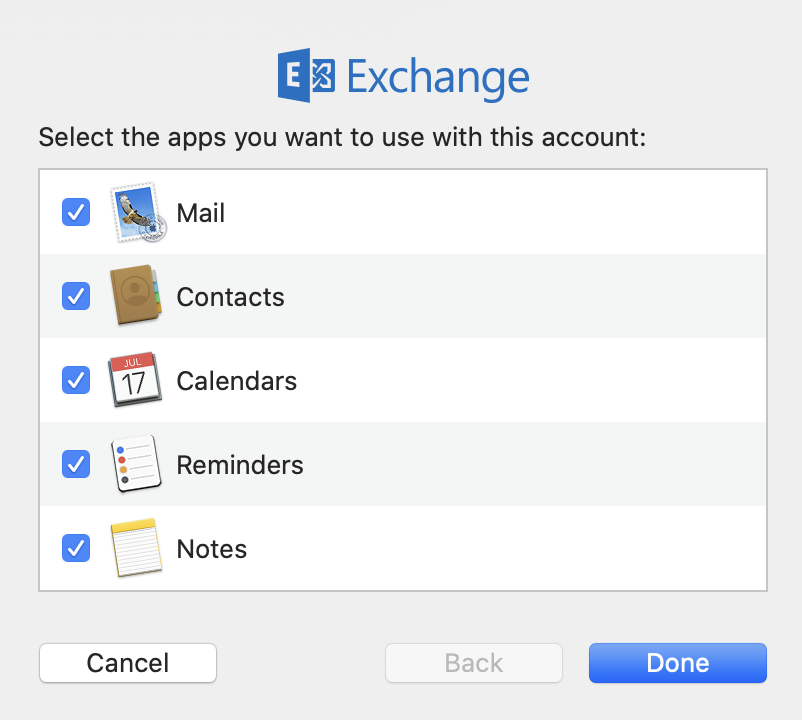
Congratulations, you’re all set. Exchange will now sync with your MacOS. If you need to make changes, you can always click on Mail > Accounts and go from there.
If the process fails for any reason, make sure you have an Autodiscover record set and pointed to the right direction. Make sure you are using the right credentials, you can test them at https://owa.xd.email/owa/ and if they work there, they should work on your Mac.
Appendix A: Hacking Autodiscover
As of Microsoft Exchange 2013 and Outlook 2013, you have to use Autodiscover records to configure Outlook. Your domain administrator must create an Autodiscover record in your domain.
Hostname: Autodiscover
Host Type: CNAME
Host value: Autodiscover.xd.email
After the host is created, it can take up to 72 hours for the DNS change to propagate (most should propagate in minutes).
If you cannot modify your DNS, you can hack it by using the Windows Hosts File. This is not recommended nor supported by ExchangeDefender and will likely be blocked by your antivirus, but if you’re technically sophisticated and can troubleshoot DNS you can point the Autodiscover.yourdomain.com hostname to the IP address of Autodiscover.xd.email. This is a temporary measure only, if you cannot immediately create a DNS record in your domain, and is not supported by our team.
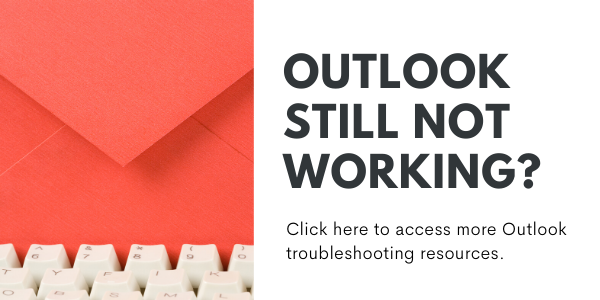
UPDATE: Exchange Migration
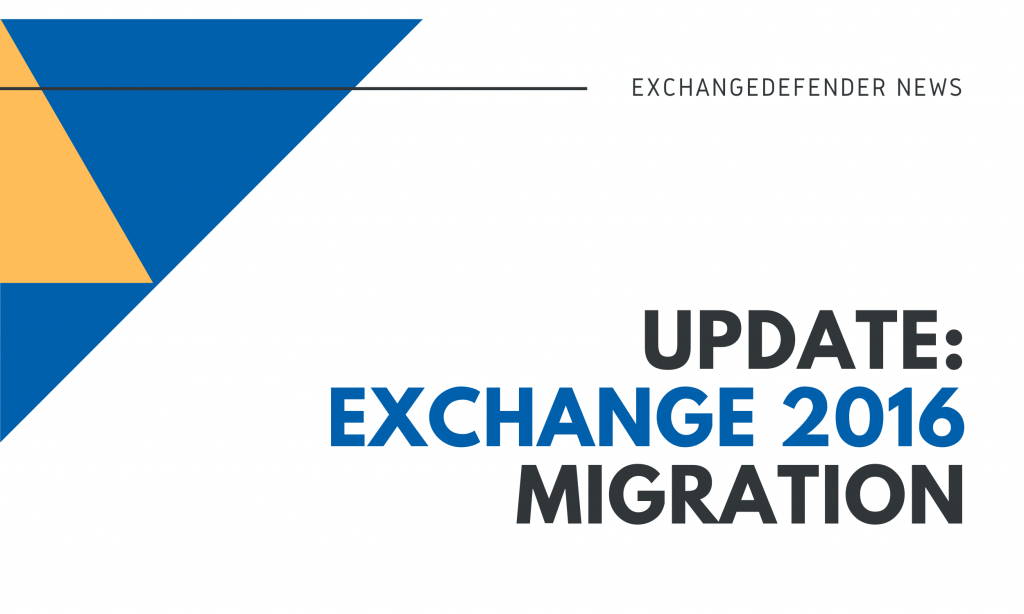
We have been keeping our partners and clients in the loop on the migration issues, around 340 accounts are still affected and we are doing everything in our power to get the last users back to productivity. As usual, all technical stuff is located on our NOC which has been updated regularly through the day/night since the first issue with legacy disconnections started:
ExchangeDefender Migration NOC Post
In the meantime:
If you are among the affected users rest assured we are doing all we can and working around the clock to get you back into your Inbox. However, just because your Outlook won’t start up doesn’t mean you cannot send and receive email from anywhere in the world. Here are the steps to enable the LiveArchive failover:
1. Go to our admin portal at https://admin.exchangedefender.com. Login as the domain admin (just type in your domain name, if you do not have the password you can get a password reminder or open a ticket with subject “LIVE ARCHIVE UNLOCK” and we’ll reset it for you)
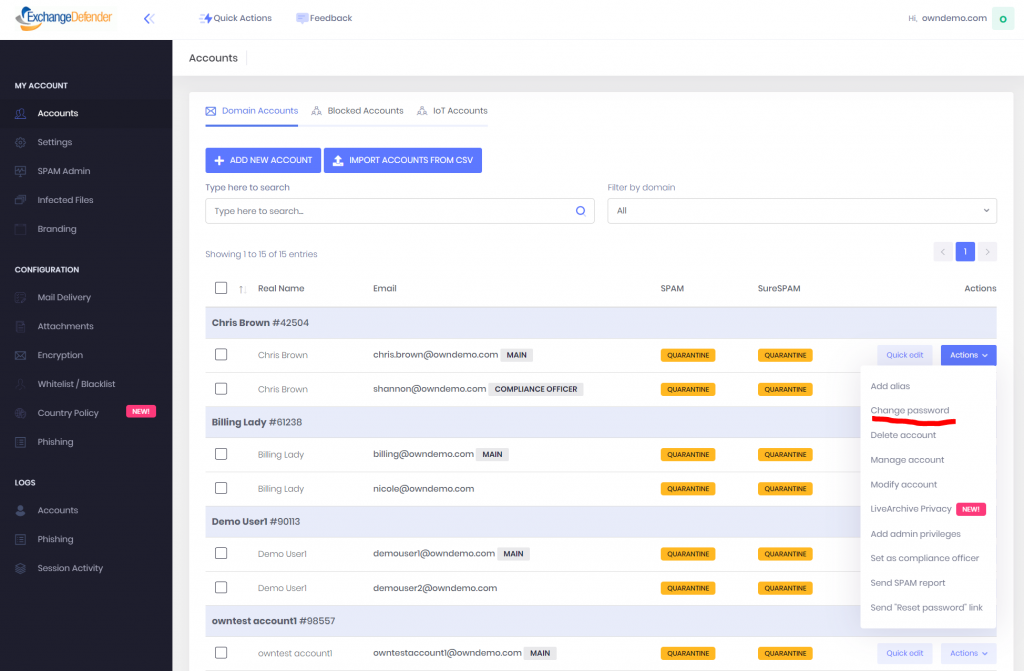
3. After you set the password it should take 1 minute for it to apply.
4. Instruct the user to go to https://nge.exchangedefender.com. Their username is their login, their password should let them in. If you run into an issue logging in, open a ticket “LIVEARCHIVE USER” with email, password and we will reset the credentials for you.
This is not available just for the affected ExchangeDefender mailboxes, this is available and included in your service for everything we protect – public folders, shared mailboxes, etc. If a folder or user is missing just create an address as a user in admin.exchangedefender.com, enable LiveArchive, set credentials, and you’ll be back to sending/receiving email.
We are still working on this, and we will not stop until everyone is back to normal, on the new platform that will be the end of legacy Exchange issues we’ve had to contend for so long. Please stay on top of the NOC, we are doing the best we can to keep everyone updated but priority is currently on restoring access and service. If your clients are upset, understandably, please point them to LiveArchive and get them back to work, it’s functional on mobile as well as the PC. Our current status is that we’re restoring mail flow and mail access to anyone, with public folder infrastructure to follow later today.
